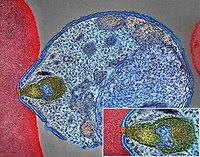
Photo from wikipedia
Introduction Malaria is still a public health problem in Africa. Seasonal Malaria Chemoprevention (SMC) is an efficient control strategy recommended by WHO that targets children under five year old living… Click to show full abstract
Introduction Malaria is still a public health problem in Africa. Seasonal Malaria Chemoprevention (SMC) is an efficient control strategy recommended by WHO that targets children under five year old living in areas of seasonal malaria transmission. SMC uses the combination amodiaquine (AQ) – sulfadoxine-pyrimethamine (SP). However SP selects rapidly drug resistant parasites. And malaria burden may increase in older children where SMC is implemented. We initiated a pilot study to assess an alternative approach to SMC in older children in Mali. Methods A randomized open-label clinical trial was conducted to test the efficacy and safety of SMC using artesunate – amodiaquine in school aged children in Mali. Two hundred pupils aged 6–15 years old were enrolled and randomized into two arms of 100 each, to receive either artesunate–amodiaquine (ASAQ) monthly or no intervention. Both arms were followed and clinical malaria were diagnosed and treated with arthemeter-lumefanthrine as recommended by Mali National Malaria Control Program. ASAQ was administered 3 days under study team direct observation and during 4 consecutive months starting in October 2013. Follow up was continued until April 2014. Results Overall, 20 cases of uncomplicated clinical malaria were encountered in the Control arm and three cases in the ASAQ arm, showing a protective efficacy of 85% 95% CI [80.1–89.9] against clinical malaria. Protective efficacy against malaria infection was 69.6% 95% CI [58.6–21.4]. No effect on anemia was observed. ASAQ was well tolerated. Most common solicited adverse events were abdominal pain and headaches of mild intensity in respectively 64% and 44% of children that swallowed ASAQ. Conclusion ASAQ is effective and well tolerated as SMC targeting older children in a peri urban setting in Mali. Its administration at schools is a feasible and accepted strategy to deliver the intervention.
Journal Title: Parasite Epidemiology and Control
Year Published: 2018
Link to full text (if available)
Share on Social Media: Sign Up to like & get
recommendations!